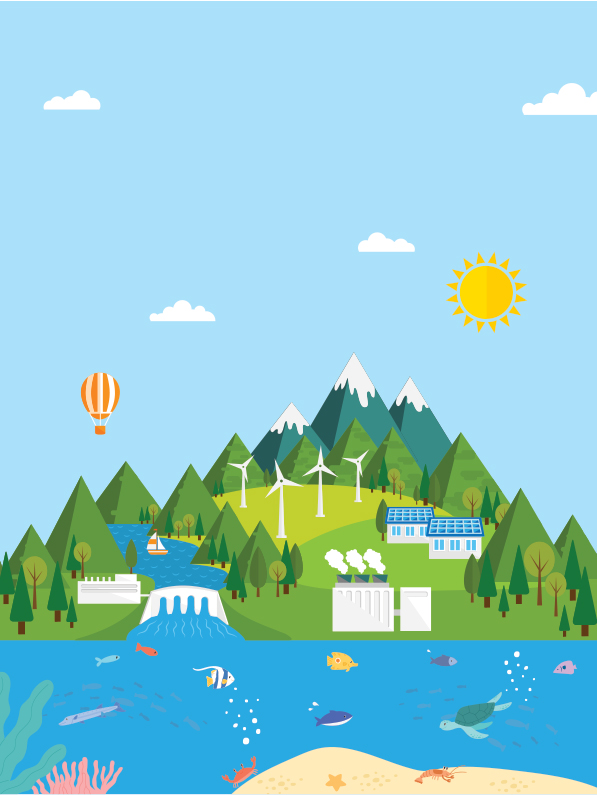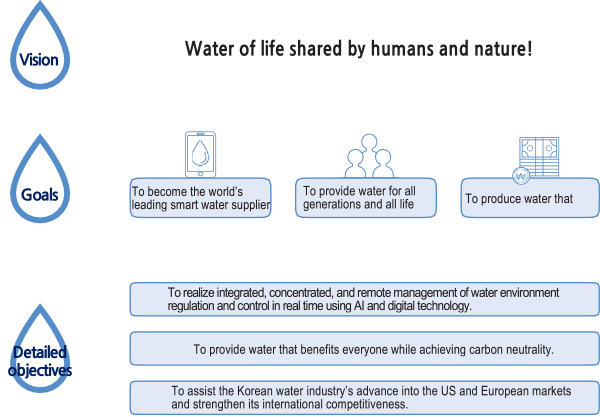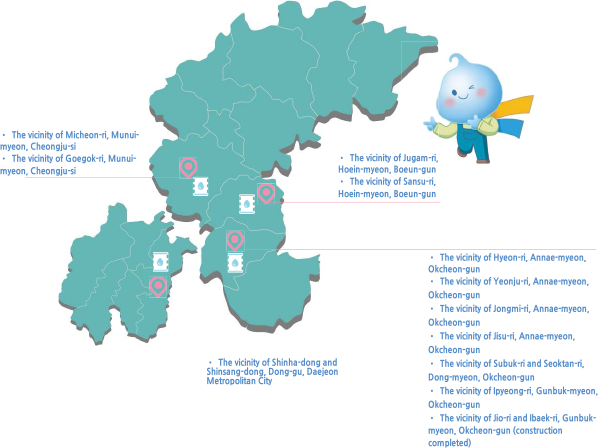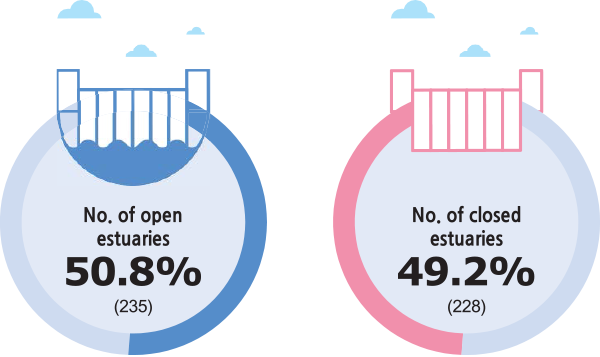
- Water, Nature and Humankind
- K-water Report
-
“K-water is striving to create a
clean and healthy water
environment from the source to
the mouth of Korea’s rivers.”- Written by. Choi Hang-jwa
- Source by. Ministry of Environment, K-water
- As climate change and ecological crises deepen, interest in the environment is growing rapidly nowadays. Every river, from its source all the way to the sea, is inhabited by diverse creatures. On the basis of integrated water management, K-water is committed to creating an environment where nature and humans can coexist, by recovering estuary ecosystems and managing water basins efficiently, and improving water quality.

Integration of river basin management to ensure stable water management
The “water environment” is a concept that encompasses both water quality and aquatic ecosystems. The status of water quality and aquatic ecosystems in Korea is generally rated as either good or average. However, the main focus of water environment of Korea has been the management of pollution sources based on main stream environments, and the management of water quality and aquatic ecosystems has largely been insufficient. Furthermore, rivers in Korea are categorized into national rivers, local rivers, and small rivers; and management entities vary depending on the river, ultimately creating management blind spots. For instance, while the main budget has been concentrated on national and local rivers, there have been difficulties in comprehensively and systematically managing small rivers, most of which are located upstream because their preservation status and management entities are diverse and the regional divisions are somewhat ambiguous.
Therefore, it became necessary to implement integrated river basic management, including upper and lower streams, in order to reduce the fundamental pollution sources of rivers and improve their water quality. By establishing integrated water management for each river basin, K-water is striving to manage water quality in a stable and sustainable manner and to protect aquatic ecosystems in response to climate change, and to enable the general public to enjoy a clean and healthy water environment.
To this end, it carries out integrated water quality and quantity surveys and investigations with the aim of creating a clean river basin water environment through the integrated operation and management of water quality data. As part of its response to climate change, K-water establishes and implements integrated water environment improvement plans that are tailored to each river basin, and encompass the entire upstream to downstream area of each dam. Furthermore, K-water also makes concerted efforts to recover the water quality of rivers through water purification by fully using the natural purification systems of rivers.
Vision for Integrated Water Management

Construction of the Geumgang Riverside Ecological Belt
K-water builds waterside ecological belts in the floodplains of dams to restore aquatic ecosystems and vitalize environmentally-friendly regions. When the water level rises due to heavy rainfall, the floodplain of a dam is used to store water; but in ordinary times, there are difficulties in preserving both the water quality and the ecosystem due to unauthorized crop cultivation and garbage dumping.
In 2020, K-water successfully implemented water management that the general public could actually feel by improving the water quality and ecosystem of the floodplain of Daecheong Dam and transforming eco-tourism into a valuable resource, as part of the trial project to build and operate two waterside ecological belts in the floodplain of Daecheong Dam in Jio-ri and Ibaek-ri in Okcheon County of Chungcheongbuk Province.
This year, K-water will build an integrated waterside ecological belt at Daecheong Dam; implement a trial project for a waterside ecological belt in the floodplain around the Sinsang District at Daecheong Dam; promote the eco-friendly management and utilization of the floodplain of Daecheong Dam and the water supply source conservation area; and provide support and cooperation for preserving and restoring the water quality and ecosystem of the Daecheong Dam watershed. Furthermore, it will establish a job creation plan based on regional participation during the construction of the sustainable waterside ecological belt and the follow-up service period.
To this end, twelve areas were selected as candidate areas based on the basic environmental study of the Geumgang river basin study conducted in 2020. Among these, K-water has been entrusted with the construction of the waterside ecological belt in the Shinsang District in Dong-gu, Daejeon, which is located in the upstream area of Daecheong Dam. This project aims to restore the floodplain of the dam into a natural waterside buffer zone and to build an integrated type of waterside ecological belt in connection with the existing waterside area by using the water system funds invested by the Ministry of Environment for the first time.
In addition to the Geumgang river basin, K-water will construct waterside ecological belts in the Yureo District near the Yeongsangang River and in the Gyeongancheon Stream near the Hangang River, thereby contributing to the improvement of the water quality and ecosystems.
Candidates for an Ecological Belt based around
Daecheong Dam (12 areas)

Restoration of the estuarine ecosystem with the opening of the Nakdonggang River estuary bank
An estuary is an area where sea and river join, and where diverse ecosystems are formed. As a habitat and spawning ground for various species of birds, fish, and animals, an estuary has great ecological value. In addition, estuaries often have rich soil and a beautiful natural environment, and their social and economic values have also been recognized.
However, as Korea underwent industrialization and urbanization, many estuaries were transformed into closed estuaries, such as estuary banks or breakwaters, in order to stop the inflow of seawater, prevent flood damage, and secure a stable water supply. When the country faces limits to growth, such as threats to the health of estuarine ecosystems caused by excessive use and development of estuarian resources, the central government, together with K-water and municipal governments, strives to protect nature by connecting sea and river and restoring estuarine ecosystems. As such, the opening of the Nakdonggang River estuary bank is part of the effort to maintain the functions of the estuary bank and recover the estuarine ecosystem. The Nakdonggang River estuary bank, built between Saha-gu and Gangseo-gu in Busan in 1987, has played the role of preventing the inflow of seawater into the lower stream area in order to secure a reliable supply of water for households, agriculture, and industry, and to control flooding in the areas of Busan, Ulsan, and Gyeongsangnam-do.
However, because of the estuary bank, the estuarine ecosystem at the mouth of the Nakdonggang River, where seawater and fresh water meet, lost its vitality, and marsh clams and reeds disappeared, thus raising the need to restore the ecosystem to its original state.
Accordingly, the government chose the Trial Opening of the Nakdonggang River Estuary Bank as a national project in 2017, and the Ministry of Environment and K-Water opened the Integrated Estuary Operation Center with the relevant agency in order to implement the trial project. These efforts made it possible to secure the technology required to establish a stable brackish water zone, and also confirmed the possibility of ecological restoration, as the return of various estuarine fish species including eels and sea bass has been observed since then.
Therefore, after the opening of the estuary bank, and as the Nakdonggang River is gradually recovering its health, we can expect to see a “Nakdonggang River estuary where a healthy ecosystem and happy life coexist in harmony”. It is also expected that the Nakdonggang River estuary will be reborn as a result of K-water’s efforts to preserve nature and create a space that benefits the public.

No. of estuaries in Korea: 463


